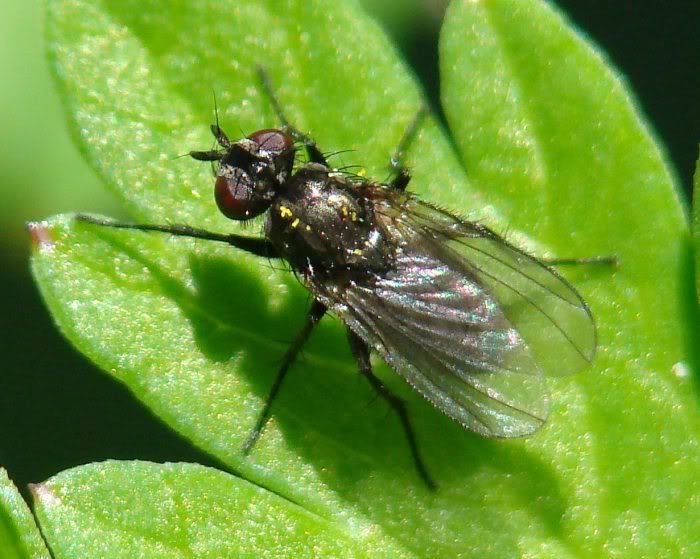Thread subject: Diptera.info :: Anthomyiidae > Acyglossa atramentaria (female)
Posted by valter on 06-04-2010 21:53
#1
Location: Algarve, Portugal
Date: April 2010
 Size
Size: smaller than Musca domestica
Thanks,
Valter
Edited by valter on 27-04-2010 08:49
Posted by jorgemotalmeida on 06-04-2010 22:15
#2
Muscidae.
Posted by javanerkelens on 06-04-2010 22:37
#3
Coenosia ?
Posted by valter on 07-04-2010 17:56
#4
Fannia manicata :)
Posted by javanerkelens on 07-04-2010 20:47
#5
I am sorry, but can you convince me why you think it is a Fannia manicata..?
The orbital plates+orbitals are indeed Fannia like, but i don't see the typical sc line on the wings..?
And i also see an ad seta on the fore tibia and i thought F.manicata has not...
Joke :)
Edited by javanerkelens on 07-04-2010 20:53
Posted by Stephane Lebrun on 07-04-2010 21:48
#6
Not
Fannia, and not
Coenosia. The wing venation is odd (no M-Cu ?). I think more about a Tachinid (Phytomyptera nigrina has this kind of venation, but I absolutely don't know this species).
Edited by Stephane Lebrun on 07-04-2010 21:49
Posted by valter on 07-04-2010 22:02
#7
javanerkelens wrote:
I am sorry, but can you convince me why you think it is a Fannia manicata..?
The orbital plates+orbitals are indeed Fannia like, but i don't see the typical sc line on the wings..?
And i also see an ad seta on the fore tibia and i thought F.manicata has not...
Joke :)
You can see the outcurved orbital seta and two dorsal setae on hind tibia.
Posted by jorgemotalmeida on 07-04-2010 22:17
#8
if tachinid... it would be a very, very unusual one!
Posted by javanerkelens on 07-04-2010 22:31
#9
I don't see strong calypters...
I get a feeling it even could be an Anthomyiidae.
(there are some species with outcurved orbitals....)
Joke
Posted by jorgemotalmeida on 07-04-2010 22:40
#10
Collect it! Hope you find it again.
Posted by Jaakko on 08-04-2010 08:04
#11
Not a tachinid, at least not a
Phytomyptera. How about one of those strange small calliphorids?
Angioneura etc? (Not any species we have in the Nordic countries)
Posted by Stephane Lebrun on 08-04-2010 17:26
#12
Ok, I was on the wrong way : the vein M should be complete and reaching the wing margin, and DM-Cu should be present. Thus it is an Antho, and with the costa stopping at R4+5 level, I propose an
Acyglossa sp. (2 species).
Posted by javanerkelens on 08-04-2010 20:25
#13
Yes !!! That is the one! Compliments
A.pollinosa = interfrontals present + thorax and abdomen greyish dusted
A.atramentaria = interfrontals absent + thorax and abdomen shining blackish with sparesely greyish dusting
Edited by javanerkelens on 08-04-2010 20:26

